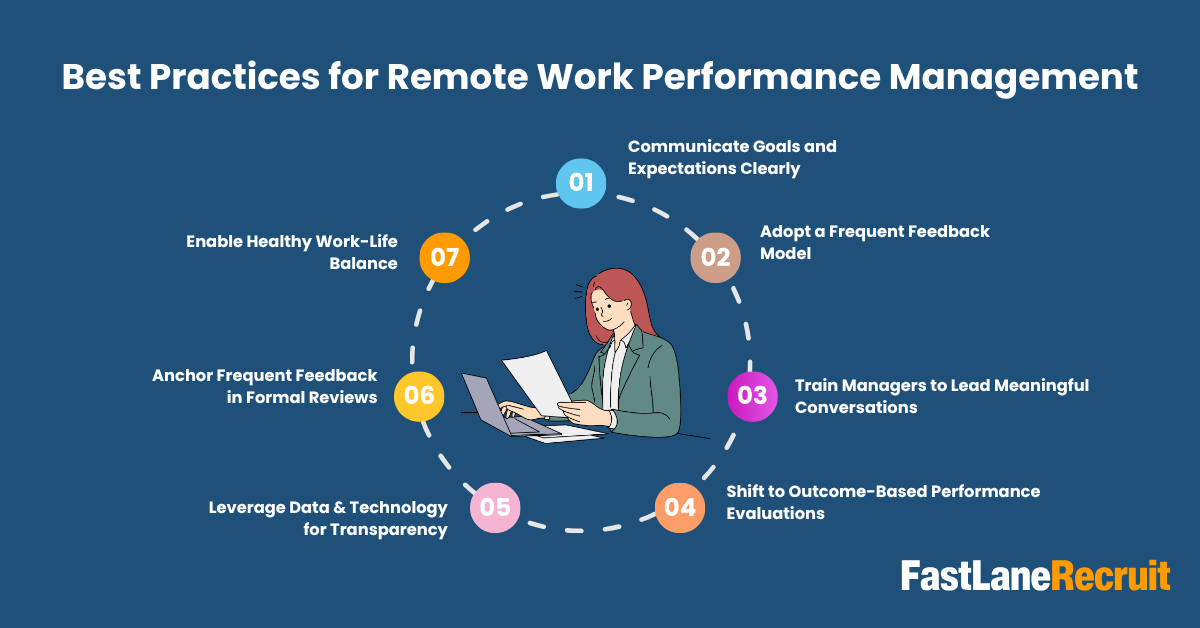As the global workforce embraces remote and hybrid work models, performance management must evolve beyond traditional metrics and methods. Remote teams require clear communication, trust-based management, and innovative techniques for tracking progress. In Malaysia and across Southeast Asia, flexible work arrangements have become mainstream, and employers are seeking sustainable frameworks to manage output, engagement, and productivity.
Governments and public-sector institutions have recognized this shift. For example, Malaysia’s Ministry of Human Resources has discussed flexible working hours and WFH arrangements under the amended Employment Act 1955, which took effect on 1 January 2023. Similarly, agencies like the U.S. Office of Personnel Management (OPM) and the UK Local Government Association have published remote performance guidance. To ensure your workforce remains efficient and aligned regardless of physical location, here are some of the best practices for performance management in remote work environments.
Content Outline
Key Summary
Set transparent, measurable goals using digital tools.
Shift from activity tracking to outcome-based performance evaluation.
Train managers in virtual coaching, active listening, and unbiased review techniques.
Use frequent, real-time feedback in combination with structured formal reviews.
Prioritise work-life balance and employee wellness.
Leverage FastLaneRecruit for expert outsourcing and recruitment in Malaysia.

Communicate Goals and Expectations Clearly
Setting clear goals is more critical than ever when managing remote employees. Without daily in-person interaction, ambiguity in roles, timelines, and deliverables can lead to confusion and missed targets.
Best practices include:
- SMART Goals: Make all goals Specific, Measurable, Achievable, Relevant, and Time-bound.
- Visible Workflows: Use shared digital platforms like Asana, Trello, or Monday.com to visually map tasks and responsibilities.
- Written Documentation: Always follow up verbal briefings with written documentation that employees can refer back to.
- Regular Goal Re-alignment: Revisit and revise goals monthly to reflect changes in company direction or project scope.
Also Read: How to Effectively Hire and Manage Remote Employees: A Comprehensive Guide
Adopt a Frequent Feedback Model
Waiting for quarterly or annual reviews can be counterproductive in a remote setting. Employees need timely, constructive feedback to adjust their course and feel connected to their team’s progress.
Best practices include:
- Weekly check-ins: Encourage managers to conduct short weekly 1-on-1s focused on current projects and challenges.
- Real-time feedback tools: Platforms like 15Five or Lattice allow quick updates and feedback loops.
- Recognition programs: Use peer-to-peer recognition systems to keep morale high.
- Pulse surveys: Send out monthly surveys to gauge satisfaction, workload, and engagement levels.
Refer to OPM’s guidelines on frequent check-ins for structuring effective touchpoints.
Feedback Models to Consider:
| Model | Frequency | Best For | Example Tools |
| One-on-One | Weekly/Biweekly | Personalized coaching | Zoom, Microsoft Teams |
| 360-Degree | Quarterly | Holistic performance review | SurveyMonkey, Lattice |
| Real-Time | Ongoing | Immediate course correction | Slack, Trello comments |
Frequent feedback helps employees stay on track and fosters a culture of open communication.
Why It Works:
- Reduces uncertainty – Employees know where they stand.
- Encourages growth – Immediate corrections prevent long-term issues.
- Builds trust – Regular interactions strengthen manager-employee relationships.
Also Read: Benefits of Global Outsourcing
Train Managers to Lead Meaningful Conversations
Performance management in a remote environment hinges on the quality of communication between employees and their supervisors.
Training managers should include:
- Active listening and empathy: Equip managers to understand verbal and non-verbal cues over video calls.
- Conversation frameworks: Tools like the SBI (Situation-Behavior-Impact) model help structure feedback constructively.
- Bias awareness: Remote environments can make unconscious bias more pronounced, e.g., favouring more visible employees.
- Development focus: Encourage developmental conversations, not just performance appraisals.
Companies that invest in coaching programs for leaders see better remote engagement and lower attrition.
Also Read: 5 Team-Building Tips for Your Remote Team
Shift to Outcome-Based Performance Evaluations
Remote performance management must move away from “input” metrics like time logged and focus on outcomes delivered.
Here’s how to make the shift:
- Define success clearly: Set key performance indicators (KPIs) that reflect the actual business value an employee generates.
- Avoid micromanagement: Trust employees to find their own best ways to achieve outcomes.
- Track outputs, not activities: Use dashboards to track results, projects completed, clients onboarded, etc.
- Standardize metrics: Ensure consistency across teams so evaluations are fair.
This shift is also aligned with Malaysia’s flexible work policy framework under the amended Employment Act 1955, which promotes outcome-driven arrangements.
Leverage Data & Technology for Transparency
Without office visibility, data becomes the central source of truth. Leverage software tools to track progress transparently across departments.
Tools and strategies include:
- Real-time dashboards: Use platforms like Power BI or Tableau to consolidate performance data.
- Time & task tracking: Tools like Toggl, ClickUp, or Hubstaff provide insights into productivity without surveillance.
- Self-service analytics: Let employees access their own performance dashboards to promote accountability.
Having a data-first mindset enables unbiased evaluations and allows team members to self-correct in real time.
Anchor Frequent Feedback in Formal Reviews
While feedback should be ongoing, formal reviews still play an important role in setting strategic direction and career development.
Enhance review cycles by:
- Using cumulative feedback: Collect inputs from weekly check-ins to prepare a holistic performance review.
- Including 360-degree reviews: Encourage peers, direct reports, and clients to offer feedback for a complete picture.
- Focusing on growth: Link reviews to training opportunities, role evolution, and long-term aspirations.
Organizations like the UK’s Local Government Association recommend blending informal feedback with formal assessments to create a comprehensive performance picture.
Enable Healthy Work-Life Balance
Burnout is a hidden risk in remote work due to blurred boundaries between work and personal life.
Promoting balance includes:
- Clear work hour policies: Define “available hours” and discourage after-hours communications.
- Encouraging breaks: Promote short, regular breaks and mental health days.
- Wellness initiatives: Offer stipends for virtual therapy, fitness classes, or ergonomic gear.
- Lead by example: Have leadership model healthy boundaries and discourage overwork.
The implementation of “Right to Disconnect” legislation in various countries (e.g., France, Ireland) highlights the global importance of supporting employees’ mental health.
Also Read: How to Build Your Own Remote Team
3 Challenges of Performance Management for Remote Workers
| Challenge | Why It Happens | Solutions |
| Managing productivity | Lack of visibility and misaligned goals | Transparent goals, real-time tracking dashboards, and regular updates |
| Reinforcing company purpose | Less exposure to mission and values in remote setups | Digital onboarding, weekly leadership updates, and cultural champions |
| Keeping employees engaged | Isolation and lack of camaraderie reduce morale | Virtual team-building, peer recognition, and mentorship programs |
Improving Employee Performance in Remote Work Environments
Improvement doesn’t come from feedback alone, it requires structured development and motivation.
Strategies include:
- Microlearning modules: Deliver short, targeted content on skill gaps identified in feedback.
- Gamification: Use scoreboards or reward systems to increase participation and engagement.
- Individual development plans (IDPs): Create IDPs with clear timelines and checkpoints.
- Employee coaching: Provide access to coaches or mentors who can help with performance goals.
- Job enrichment: Redesign roles to include more meaningful and varied tasks to maintain interest.
When employees feel supported and challenged, their performance naturally improves, even at a distance.
Conclusion
Effective remote performance management requires a blend of technology, trust, and tailored strategies. It is no longer enough to track attendance or output alone. Organizations must focus on employee development, engagement, and overall well-being while reinforcing accountability and company culture. By applying these best practices, employers can build resilient, high-performing remote teams.
How FastLaneRecruit Can Help You Hire Remote Malaysian Employees
Whether you’re looking to expand your remote workforce or outsource your operations in Malaysia, FastLaneRecruit offers a tailored recruitment and HR outsourcing solution. From sourcing top-tier Malaysian professionals to managing payroll and statutory compliance, we ensure that your remote performance strategies align with local labour laws and business goals.
Partner with FastLaneRecruit today to discover a seamless, scalable solution to building high-performing remote teams. Contact us now!


